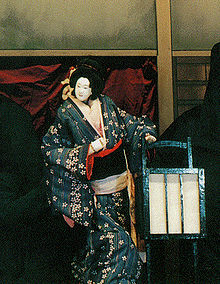This article needs additional citations for verification. (April 2022) |

Bunraku (文楽) (also known as Ningyō jōruri (人形浄瑠璃)) is a form of traditional Japanese puppet theatre, founded in Osaka in the beginning of the 17th century, which is still performed in the modern day.[1] Three kinds of performers take part in a bunraku performance: the Ningyōtsukai or Ningyōzukai (puppeteers), the tayū (chanters), and shamisen musicians. Occasionally other instruments such as taiko drums will be used. The combination of chanting and shamisen playing is called jōruri and the Japanese word for puppet (or dolls, generally) is ningyō. It is used in many plays.
- ^ "The History of Bunraku 1". The Puppet Theater of Japan: Bunraku. An Introduction to Bunraku: A Guide to Watching Japan's Puppet Theater. Japan Arts Council. 2004. Archived from the original on 6 September 2011. Retrieved 6 September 2011.